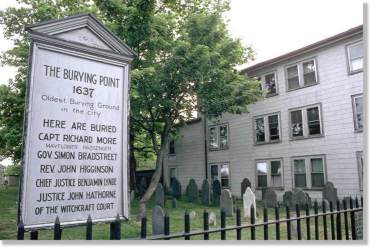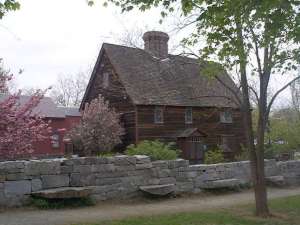Charter Street
- Home
- About Salem »
- Salem Tales »
- Charter Street
Chart(er)ing a Course through Times Past
Charter Street
It may not be as beautiful or architecturally significant as Chestnut Street or Federal Street or even Washington Square. But tiny Charter Street, all of two blocks long, has enough history associated with it to be listed on the National Register of Historic Places.
Charter Street was laid out in 1767 as a town street and ran between the town wharf on the South River at the foot of Market (now Central) Street and a cove in front of what is now Immaculate Conception Church. The portion east of Liberty Street was originally called Vine Street.
The street boasts the city’s oldest cemetery. In 1637 the town voted to set aside a point of land overlooking the South River as a burial ground. The site was probably already being used for that purpose. Historian Sidney Perley suggested that many of the settlers who succumbed in the great sicknesses of 1628 and 1629, including the wife of Gov. John Endicott, had been buried there.

The Burying Point Photo: Jim McAllister
In 1637 John Home was given permission to erect and operate a windmill in the Burying Point, and John Cromwell was later granted the right to graze cattle there. Eventually the riverbank on the southern end of the Burying Point filled with wharves and warehouses.
Additional land was acquired by the town in later years for cemetery expansion. The entrance was moved from Liberty Street to Charter Street when the latter came into existence in 1767.
McIntire buried here
Some of the more famous internees at the Burying Point are Richard More, a passenger on the original voyage of the Mayflower, and witch trial judges John Hathorne and Bartholomew Gedney. For some inexplicable reason Gedney’s name and that of Salem’s famous architect and woodcarver, Samuel McIntire, who was buried here in 1811, are not listed on the historic plaque at the entrance to the cemetery.
Simon Bradstreet, a Massachusetts governor who lived in Salem, is listed on that marker and his tomb is adorned with a bronze plaque in both Latin and English. Bradstreet’s family however, sold the family tomb in the early 1800s, and the governor’s remains were removed.
Another 17th century stone marks the grave of Nathaniel Mather, brother of the legendary Puritan divine and witchcraft expert Cotton Mather.
Links to Hawthorne
Nathaniel Hawthorne frequented the cemetery in his solitary rambles about Salem and used names he found on headstones in some of his writings. The most popular were his ancestor, John Hathorne, and Dr. Swinnerton. The Swinnerton name appears in “The House of the Seven Gables” and the author’s unfinished “Dolliver Romance.”
The cemetery itself is mentioned in Hawthorne’s “Dr. Grimshawe’s Secret,” as is the adjoining gray-shingled house at 53 Charter St. It was there in what is now called the Grimshawe House that Hawthorne met his future wife, Sophia, in 1837. The author had been invited to the Peabody home by the eldest of the three famous Peabody sisters, Elizabeth Palmer Peabody, who would later achieve fame as the mother of the American kindergarten movement.
Another caller at the house on Charter Street, the famed educator Horace Mann, would marry the third Peabody sister, Mary.
At the corner of Charter and Liberty Streets stands the Samuel Pickman house. In the early 1960s, after attending three lectures on Colonial architecture given by expert Abbott Lowell Cumins, Salem resident Elizabeth Reardon discovered this 17th century dwelling under a Victorian mansard roof.

The Pickman House, Salem’s oldest building, corner of Liberty and Charter Streets.
The house may have been built as early as 1664 for Samuel Pickman, and is one of Salem’s oldest buildings. It was acquired in 1964 and partially restored by Historic Salem, Inc. When it became obvious that the building needed major structural work, Historic Salem sold the Pickman house to a private developer, who then completed the restoration. The building is now owned by the Peabody Essex Museum.
The first hospital
One significant piece of the street’s history is no longer extant: the original Salem Hospital complex. In 1874, Salem merchant-philanthropist John Bertram donated $25,000 and a mansion at 31 Charter St. toward the establishment of a hospital for the city. The hospital corporation was subsequently chartered by the Commonwealth of Massachusetts with James Curwen as president.
Salem Hospital opened for business on Oct. 1, 1874. The new medical facility occupied the western portion of the building, and the other half was leased to a tenant. The hospital had 12 beds and a medical staff of 13 doctors headed by David Coggin.
The new hospital grew in size and scope over the next decade, adding a maternity ward, an eye clinic, and a training school for nurses. A three-story wing was built onto the rear of the original structure in 1884, and a separate, free-standing maternity ward was added three years later. Gradually the hospital complex was expanded to include eight buildings located on Charter Street, both sides of Derby Street, and on Liberty Street.
Many of those buildings were destroyed or severely damaged during the Salem Fire of 1914. Shortly after the fire, a decision was made to move the facility to a site with more open space for future expansion and less noise and traffic. Salem Hospital remained on Charter Street until 1917, when its new complex on Highland Avenue was finally completed.
Jim McAllister
All rights reserved

